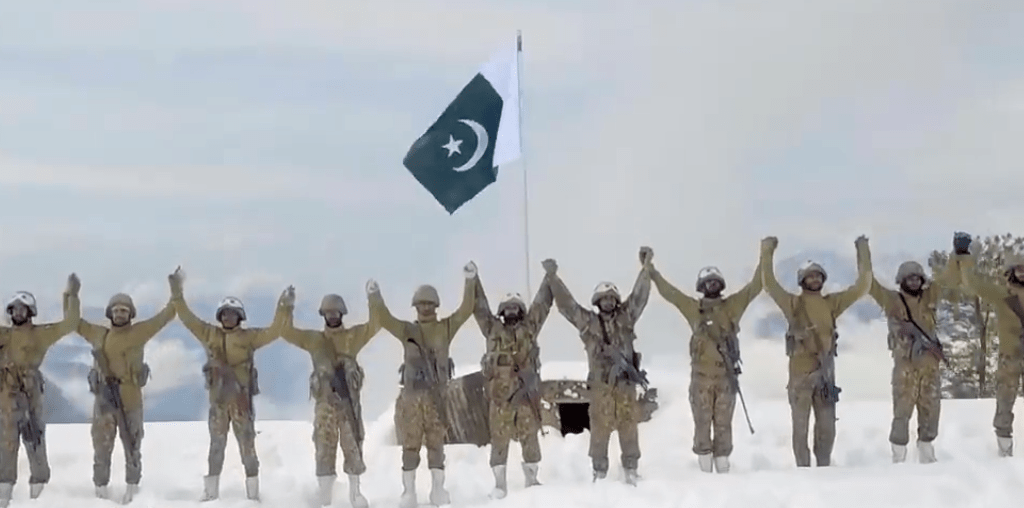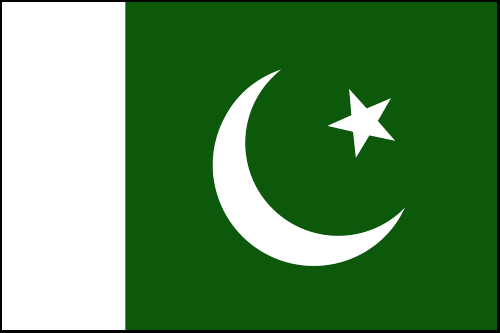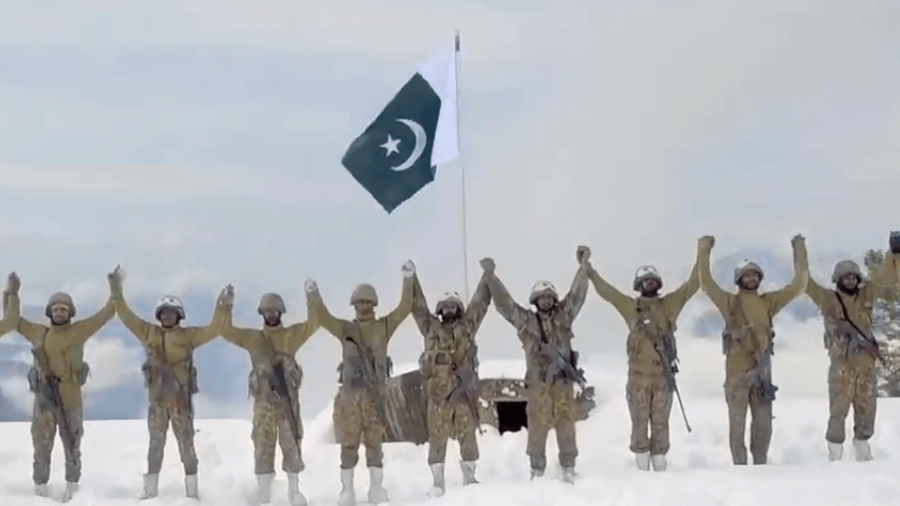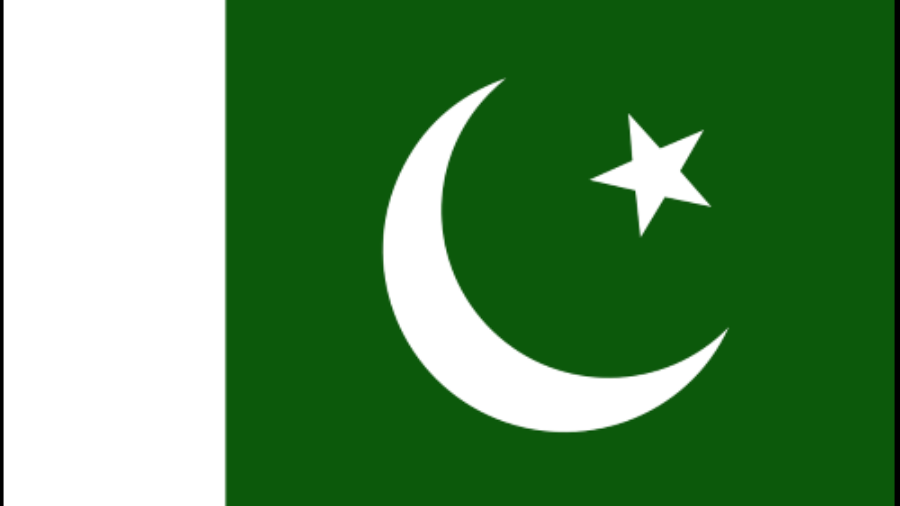
Pakistan Flag

Pakistan Flag
The Pakistan flag, also known as the national flag of Pakistan (Islamic Republic of Pakistan), is an energetic symbol of the country’s rich history, culture, and identity. Comprising a green field with a white crescent moon and a five-pointed star, the flag holds deep symbolism that reflects the aspirations and unity of the Pakistani people. The green portion of the flag represents the Muslim majority of Pakistan, embodying growth and prosperity, while the white stripe signifies religious minorities and the pursuit of peace.
Adopted on August 14, 1947, upon gaining independence from British colonial rule, the Pakistan flag embodies the country’s rich history and culture. This flag’s history traces back to the Lahore session of the All-India Muslim League in 1940, culminating in its adoption after Pakistan gained independence in 1947. It is raised proudly during national holidays like Independence Day and Republic Day, symbolizing the nation’s unwavering spirit. Respecting the flag’s sanctity is crucial, as it reflects the heart and soul of Pakistan’s identity and aspirations.
By understanding the flag’s design, history, and significance, we gain insight into the heart of Pakistan’s identity.
In this article, we explore into the various aspects of the Pakistan flag, exploring its design, colors, historical significance, cultural importance and many more.
Table of Contents
- Pakistan Flag
- What is flag?
- Objectives, Determinations, Intentions, Aims, Goals, Purposes of Flag
- National Flag:
- Introduction of Pakistan Flag:
- History of the Pakistan Flag:
- Pakistan Flag Symbolism:
- Meaning of Pakistan Flag:
- Designer of Pakistan Flag:
- Pakistan National Symbols:
- Significance of Green and White Colors:
- Unity in Diversity:
- Crescent Moon and Star Symbolism:
- Pakistan Flag on National Holidays:
- Pakistani Identity and the Flag:
- Freedom Struggle and the Flag:
- Protocol and Display:
- Origin of Pakistan Flag
- Colors and symbols used in Pakistan Flag:
- Official Design and Specification of Pakistan Flag
- Color code of Pakistan Flag:
- Read More Articles on Flags – You May Like
- FAQs: Pakistan Flag.
What is flag?
A flag is a visual representation or symbol that is typically made of cloth and is often rectangular in shape. Flags are used to convey information, identity, or affiliation and are often associated with countries, regions, organizations, or causes. They usually feature a combination of colors, shapes, symbols, or patterns that carry specific meanings or messages.
Flags can be displayed on flagpoles, buildings, vehicles, and various other locations to showcase the entity they represent. Additionally, flags are often raised during official events, ceremonies, and celebrations to honor and symbolize the entity they stand for.
Objectives, Determinations, Intentions, Aims, Goals, Purposes of Flag
Flags serve a variety of purposes, including:
1. National Identity:
Flags are most commonly associated with countries and serve as a visual representation of a nation’s identity, history, culture, and values. They are often displayed on government buildings, public spaces, and during national events.
2. Communication:
Flags can communicate messages without the need for words. Different colors, symbols, or patterns on a flag can convey various meanings, such as indicating the presence of danger, marking a location, or representing a group’s beliefs.
3. Representation:
Flags can represent various entities, including regions, states, provinces, or cities within a country. For instance, states within a federal nation might have their own flags that symbolize their unique identity.
4. Cultural and Religious Significance:
In some cases, flags carry cultural or religious significance. They might incorporate religious symbols, historical references, or traditional motifs that hold importance within a particular community.
5. Events and Celebrations:
Flags are often used during celebrations, ceremonies, and events to create a festive atmosphere and to highlight the occasion. They can enhance the visual appeal and sense of unity during such gatherings.
6. Military and Identity:
Military units, ships, and aircraft often have their own flags that signify their unit, rank, or purpose. These flags help distinguish different units and are used for signaling and identification.
Overall, flags play a crucial role in conveying identity, values, and messages across a wide range of contexts, making them an integral part of human communication and culture.
National Flag:
A national flag is a symbol that represents a country’s identity, history, values, and aspirations. It serves as a unifying emblem for the citizens and a means of identifying the nation on the global stage. National flags typically consist of unique designs, colors, and symbols that hold significant meaning and are deeply rooted in the culture and history of the country they represent.
Ideology of National Flag:
The ideology of a national flag is the set of principles, values, and beliefs that it embodies. It reflects the collective spirit of the nation, often encompassing themes such as unity, freedom, patriotism, diversity, and cultural heritage. The design and symbolism of a national flag are carefully chosen to encapsulate these ideals and evoke a sense of pride and identity among its people.

Introduction of Pakistan Flag:
The national flag of Pakistan features a green field with a white crescent moon and a five-pointed white star situated at the hoist side. The green color represents Islam, while the white color symbolizes religious minorities and purity. Progress is symbolized by the crescent moon, while light and understanding are represented by the star. It was officially adopted on August 14, 1947, coinciding with Pakistan’s independence from British rule.
History of the Pakistan Flag:
The idea of a separate Muslim state within British India had gained momentum during the early 20th century, culminating in the creation of Pakistan in 1947. The flag was designed to symbolize the new nation’s Islamic identity while also embracing its diverse cultural heritage.
The Pakistan flag was officially adopted on August 14, 1947, the same day that Pakistan gained independence from British rule.
The flag’s design was the result of a competition, and the winning design was submitted by Syed Amir-udDin Kedwaii. The flag’s creation was informed by the vision of the country’s founder, Muhammad Ali Jinnah, who sought a flag that would represent the unity and diversity of the newly formed nation.
The flag was first raised at Karachi’s (then capital of Pakistan) Civic Centre on August 14, 1947.
The Pakistan flag played a significant role during the freedom struggle. It was hoisted for the first time on August 14, 1947. The flag played a crucial role in rallying the people during the independence movement and continues to be a symbol of national pride and unity. It was raised alongside the Indian flag on August 14, 1947, symbolizing the birth of the new nation.
Pakistan Flag Symbolism:
The Pakistan flag’s design holds profound symbolism. The green color represents growth, prosperity, and hope, while the white stripe symbolizes purity and peace. The white crescent moon symbolizes progress and advancement, while the five-pointed star represents light, knowledge, and the five pillars of Islam. Together, these symbols convey the principles of unity, diversity, progress, and enlightenment.
Meaning of Pakistan Flag:
The green background of the Pakistan flag signifies the fertile land and agricultural wealth of the nation. The white crescent moon represents progress and the star represents knowledge. Together, they stand for the country’s progress towards prosperity and enlightenment.
Designer of Pakistan Flag:
The Pakistan flag was designed by Syed Amir-udDin Kedwaii, an educated young man from Karachi who won a design competition held by the Constituent Assembly of Pakistan in 1947.
Pakistan National Symbols:
The Pakistan flag is one of the most significant national symbols of the country. It stands as a visual representation of Pakistan’s identity, values, and struggles. Alongside other national symbols, such as the national anthem and the state emblem, the flag fosters a sense of belonging and patriotism among the people of Pakistan.
Significance of Green and White Colors:
The green color in the flag represents the majority Muslim population of Pakistan and their connection to Islam. It also symbolizes growth and hope. The white color signifies the religious minorities and their role in the nation’s progress and development. Together, these colors embody unity in diversity.
Unity in Diversity:
The design of the Pakistan flag embodies the concept of unity among the diverse ethnic, linguistic, and cultural groups within the nation. The flag’s colors and symbols serve as a reminder that despite differences, the people of Pakistan are united under a common national identity.
Crescent Moon and Star Symbolism:
The white crescent moon represents progress and advancement, while the five-pointed star symbolizes light, knowledge, and unity among the country’s various regions.
Pakistan Flag on National Holidays:
The Pakistan flag holds special significance during national holidays and celebrations, such as Independence Day (August 14) and Republic Day (March 23). It is hoisted at government buildings, educational institutions, public spaces, and homes across the country. This act reinforces a sense of national identity and unity among the citizens.
Pakistani Identity and the Flag:
The Pakistan flag plays a crucial role in shaping the nation’s identity. It instills a sense of belonging and pride among the people, reinforcing their connection to the country and its shared history.
Freedom Struggle and the Flag:
During Pakistan’s struggle for independence, the flag became a powerful symbol of the nation’s aspirations for sovereignty. It was a rallying point for the people, inspiring them to work together for a free and independent Pakistan. It was raised during protests, demonstrations, and rallies, representing the hopes and aspirations of the people for a sovereign and independent nation. The flag’s significance has only grown since then, serving as a testament to the nation’s journey towards progress and self-determination.
Protocol and Display:
The Pakistan flag is treated with immense respect and has specific guidelines for proper display. It should always be raised briskly and lowered slowly. When displayed horizontally, the green portion should be at the viewer’s left and the white at the right. It’s often hoisted on national holidays, official events, and important government buildings.
The Pakistan flag is a testament to the country’s rich history, diverse culture, and enduring spirit. Its colors, symbols, and design encapsulate the ideals of unity, diversity, progress, and hope that are at the heart of the nation’s identity.
Origin of Pakistan Flag
The origin of the Pakistan flag dates back to the time of the country’s struggle for independence and its subsequent creation as a separate nation. The flag’s design was influenced by the vision of Pakistan’s founder, Muhammad Ali Jinnah, and it was adopted on August 14, 1947, when Pakistan gained independence from British colonial rule.
The flag’s origin can be summarized as follows:
1. Design Process:
The design of the Pakistan Flag emerged from a national competition organized by the All-India Muslim League, which was the leading political party representing the Muslims of India. The party’s leadership, including Muhammad Ali Jinnah, recognized the need for a distinct flag that would symbolize the identity and aspirations of the Muslim-majority regions in India that would become Pakistan.
2. Design Competition:
In 1947, as the independence of Pakistan was imminent, a competition was held to design the national flag of the new nation. This competition aimed to create a symbol that would represent Pakistan’s identity, values, and aspirations.
3. Syed Amir-udDin Kedwaii: (Design the National Flag of Pakistan)
Syed Amir-uddin Kedwaii, a young man, won the competition. His design was selected from among hundreds of submissions. With his unique design, which eventually became the official flag of Pakistan. The design consisted of a green field with a white crescent moon and a five-pointed star in the center. The green color represented the majority Muslim population and their connection to Islam, while the white color symbolized the religious minorities and their role in the nation’s progress. The crescent moon stood for progress and the star for knowledge and unity.
4. Vision of Muhammad Ali Jinnah:
The flag’s design was based on the vision of Muhammad Ali Jinnah, who was the leader of the All-India Muslim League and a prominent figure in the struggle for Pakistan’s creation. Jinnah emphasized the importance of having a flag that would represent the unity and diversity of the newly formed nation, while also embodying the principles of Islam and progress. The Pakistan flag was first hoisted at Karachi’s (then the capital of Pakistan) Civic Centre on August 14, 1947, marking Pakistan’s independence from British rule. The flag-raising ceremony was a historic moment that celebrated the birth of a new nation and its journey towards self-determination
5. Symbolism and Elements:
The Pakistan flag’s design consists of a green field with a white crescent moon and a five-pointed white star situated at the hoist side. The green color represents Islam and the Muslim majority, while the white color symbolizes religious minorities and purity. The crescent moon represents progress and advancement, and the star symbolizes light and knowledge.
6. Adoption and Independence:
The Pakistan Flag was officially adopted on August 14, 1947, which is the same day that Pakistan gained independence from British rule. This historic day marked the birth of the new nation of Pakistan, and the flag was raised for the first time as a symbol of the country’s sovereignty, identity, and the struggle of its people for self-determination.
The Pakistan flag’s origin is deeply intertwined with the struggle for independence and the aspirations of the people to create a nation based on principles of unity, diversity, and progress. It has since become a powerful symbol of Pakistan’s identity and is proudly displayed during national events, celebrations, and ceremonies.
The origin of the Pakistan Flag lies in the collective desire of the Muslim community in the Indian subcontinent to have a distinct symbol that would represent their identity and aspirations as they embarked on the journey of independence and nationhood. The winning design, with its green background, white crescent, and star, captured the essence of unity, diversity, and progress that Pakistan aimed to achieve as a newly independent nation.

Colors and symbols used in Pakistan Flag:
Colors = Green and Write.
Symbols = White Crescent Moon and Five-Pointed Star.
Green color in Pakistan’s flag:
The green color in Pakistan’s flag holds profound symbolism and represents several significant aspects of the nation’s identity, values, and heritage. The green field is the dominant color in the flag’s design and carries deep meaning that resonates with the Pakistani people. Here are some of the meanings and interpretations associated with the green color in Pakistan’s flag:
- Islamic Identity: Green is often considered a symbolic color in Islamic culture and is associated with Islam’s teachings and principles. In the context of Pakistan, the green color represents the nation’s strong Islamic identity and its connection to the faith that plays a central role in the lives of its citizens.
- Fertile Land: The green color in the flag can be interpreted as a representation of Pakistan’s fertile land and agricultural wealth. It symbolizes the nation’s agrarian heritage and its significance in supporting the economy and livelihoods of a significant portion of the population.
- Growth and Prosperity: Green is commonly associated with growth, renewal, and prosperity. It reflects Pakistan’s aspirations for progress, development, and economic well-being for its people. The color embodies the country’s hopes for a better future and improved quality of life.
- Natural Beauty: The green color also reflects the natural beauty and diverse landscapes of Pakistan, which include lush forests, valleys, and fields. It represents the rich biodiversity of the region and the appreciation for the country’s scenic beauty.
- Unity in Diversity: Green can be seen as a unifying color that symbolizes the diverse cultures, languages, and ethnicities that make up Pakistan. It underscores the idea that despite these differences, the people of Pakistan are united under a common flag and share a collective identity.
- Patriotism: The green color serves as a symbol of patriotism and national pride. It represents the love and loyalty of the Pakistani people to their country, its values, and its history.
- Hope and Optimism: Green is frequently linked to optimism and hope. It signifies Pakistan’s optimism for a better future, where challenges are overcome and the nation thrives.
Overall, the green color in Pakistan’s flag carries a rich tapestry of meanings, ranging from its Islamic heritage to its agricultural significance, growth and development aspirations, unity, and national pride. It serves as a reminder of the country’s values, identity, and the collective dreams of its people.
White color in Pakistan’s flag:
The white color in Pakistan’s flag also holds significant symbolism and represents various important aspects of the nation’s identity, values, and principles. The white stripe in the flag’s design carries deep meaning that reflects the Pakistani people’s ideals and aspirations. Here are some of the meanings and interpretations associated with the white color in Pakistan’s flag:
- Purity and Peace: White is often associated with purity, innocence, and peace. In the context of Pakistan’s flag, the white color symbolizes the nation’s commitment to these values, emphasizing the importance of maintaining peace within the country and promoting harmony among its citizens.
- Religious Minorities: The white color represents the religious minorities within Pakistan. It reflects the nation’s recognition of the diverse religious groups that coexist within its borders and acknowledges their contributions to the country’s progress and development.
- Tolerance and Unity: White is a color that transcends differences and promotes unity. In Pakistan’s flag, the white color serves as a reminder of the nation’s commitment to religious tolerance, social cohesion, and the importance of embracing diversity.
- Equality and Justice: The white color can also be associated with equality and justice. It symbolizes Pakistan’s aspiration to ensure fair treatment and equal rights for all its citizens, regardless of their background or beliefs.
- Blank Slate and New Beginnings: White can be seen as a blank canvas symbolizing new beginnings and opportunities. It represents Pakistan’s ongoing journey as a young nation, continuously striving for progress, development, and positive change.
- Humanitarian Values: The white color carries associations with humanitarian values, compassion, and humanitarianism. It reflects Pakistan’s commitment to caring for its citizens and contributing to global efforts to alleviate suffering and promote human welfare.
- Coexistence: The white color signifies the peaceful coexistence of various communities and cultures within Pakistan. It highlights the importance of working together harmoniously for the betterment of the nation.
- International Relations: The white color can be seen as a representation of Pakistan’s commitment to peaceful international relations. It reflects the nation’s desire to be a responsible member of the global community and to contribute positively to global issues
Overall, the white color in Pakistan’s flag embodies ideals of purity, peace, unity, tolerance, and equality. It serves as a visual representation of the nation’s commitment to fostering an inclusive society where all citizens are valued and treated with respect, and where differences are celebrated as strengths.
Crescent moon in Pakistan’s flag:
The crescent moon in Pakistan’s flag holds significant symbolism and represents various aspects of the nation’s identity and aspirations. The crescent moon is positioned alongside a five-pointed star on a green field in the flag’s design. Here are some of the meanings and interpretations associated with the crescent moon in Pakistan’s flag:
- Progress and Growth: The crescent moon is often seen as a symbol of progress, growth, and advancement. In the context of Pakistan, it signifies the nation’s continuous journey towards development, prosperity, and improvement in various fields, including education, technology, and economy.
- Islamic Faith: The crescent moon is a well-known symbol in Islam and is often associated with the faith’s religious and cultural heritage. It’s widely recognized as a symbol of the Islamic calendar, marking the beginning of the new lunar months and important Islamic festivals. In the context of the Pakistan flag, the crescent moon represents the predominant religion of the nation, Islam. Pakistan was created as a homeland for Muslims, and the crescent moon serves as a reminder of the country’s Islamic identity.
- Aspirations and Hopes: The crescent moon can also be seen as a representation of the collective hopes, dreams, and aspirations of the Pakistani people. It serves as a reminder of the nation’s potential and the aspirations of its citizens to achieve greatness and make positive contributions to the world.
- Unity and Oneness: The crescent shape can symbolize unity and oneness, reflecting the idea that despite the diverse cultures, languages, and backgrounds within Pakistan, the people are united under a common flag and a shared national identity.
- Guidance and Enlightenment: In many cultures, the crescent moon is associated with guidance, enlightenment, and illumination. In Pakistan’s flag, it can be seen as a symbol of the nation’s pursuit of knowledge, education, and enlightenment for its citizens.
- Resilience and Perseverance: The phases of the moon, including the crescent shape, can be interpreted as a representation of cycles and change. This can symbolize the resilience and perseverance of the Pakistani people in the face of challenges, reflecting their ability to adapt and overcome difficulties.
Overall, the crescent moon in Pakistan’s flag is a multi-faceted symbol that encapsulates the nation’s Islamic identity, its journey towards progress and growth, its unity in diversity, and its collective hopes and aspirations. It serves as a powerful reminder of Pakistan’s history, culture, and the values that the nation holds dear.
Star in Pakistan’s flag:
The star in Pakistan’s flag holds significant symbolism and represents several key aspects of the nation’s identity, values, and aspirations. Positioned alongside the crescent moon on a green field, the star is a prominent element in the flag’s design. Here are some of the meanings and interpretations associated with the star in Pakistan’s flag:
- Unity and Solidarity: The star is often seen as a symbol of unity, solidarity, and harmony. In the context of Pakistan, it represents the nation’s diverse regions, ethnicities, and cultures coming together as one united entity. The star serves as a reminder that despite differences, the people of Pakistan are bound by a common national identity.
- Guidance and Leadership: Stars have historically been used as navigational guides and sources of light in the darkness. The star in Pakistan’s flag can be interpreted as a symbol of guidance and leadership, representing the nation’s commitment to progress and enlightenment.
- Aspirations and Ambitions: The star can also be seen as a representation of the nation’s aspirations and ambitions. It symbolizes the Pakistani people’s desire to reach for the stars, achieve greatness, and make positive contributions to various fields, including science, technology, culture, and international relations.
- Five Pillars of Islam: The five-pointed star can be associated with the Five Pillars of Islam, which are the core principles and practices that guide the lives of Muslims. Pakistan’s flag includes the star as a reflection of the country’s Islamic identity and its commitment to upholding the values of Islam.
- Progress and Development: Similar to the crescent moon, the star also represents progress, growth, and development. It signifies Pakistan’s efforts to move forward, improve the quality of life for its citizens, and achieve economic and social advancement.
- National Unity: The star serves as a powerful symbol of national unity, underscoring the importance of coming together as a single nation to overcome challenges, achieve goals, and build a better future for all.
Overall, the star in Pakistan’s flag is a meaningful emblem that encapsulates the nation’s unity, aspirations, Islamic heritage, progress, and commitment to guiding principles. It reinforces the values of unity in diversity, progress, and enlightenment that are central to Pakistan’s identity and history.
Official Design and Specification of Pakistan Flag
The official design of the Pakistan flag consists of a green field with a white vertical stripe on the hoist side. Centered within the white stripe is a white crescent moon and a five-pointed star. The flag’s dimensions and proportions are specified in Pakistan’s national regulations. The proportions of the flag are typically 2:3, meaning that the width of the flag is two-thirds of its length.
To summarize:
- Field Color: Green
- Vertical Stripe: White
- Symbols: White Crescent Moon and Five-Pointed Star
- Proportions: 2:3, meaning that the width of the flag is two-thirds of its length.
The green color represents the Muslim majority, growth, and prosperity, while the white stripe symbolizes religious minorities, peace, and harmony. The white crescent moon and star are symbols of Islam, progress, enlightenment, and unity.
The flag’s design embodies the ideals of unity among diverse communities, progress, and the Islamic heritage of Pakistan.
The Pakistan flag has specific dimensions and proportions that are defined to ensure its proper representation. The flag’s dimensions are as follows:
Width: The width of the Pakistan flag is twice its height.
Length: The length of the Pakistan flag is three times its height.
In other words, the flag’s aspect ratio is 2:3, meaning that for every 2 units of width, there are 3 units of height.
This proportion ensures that the flag’s design and symbols are correctly displayed and recognizable. The green field and the white stripe are laid out according to this aspect ratio to maintain the flag’s visual integrity and symbolism.
Learn more about Pakistan Flag specification: https://pakistani.org/pakistan/flagspec.html
Color code of Pakistan Flag:
The color code of the Pakistan flag is as follows:
- Green Color: The green color in the Pakistan flag is typically represented using the Pantone shade called “Dark Green” or “Pakistan Green,”. The green color in the Pakistan flag is often represented using the hex color code #18453B.
- White Color: The white color in the Pakistan flag is usually represented using pure white. The white color in the Pakistan flag is simply represented using the hex color code #FFFFFF.
It’s important to note that while these color codes provide a standardized representation of the colors used in the Pakistan flag, variations in color perception and reproduction can occur due to factors such as printing methods, display devices, and lighting conditions. The specific shades of green and white used in the flag are symbolic and hold cultural and historical significance for the nation.
Read More Articles on Flags – You May Like
FAQs: Pakistan Flag.
- What is the Pakistan flag?
- Ans: The Pakistan flag is the national symbol that symbolizes the country’s identity, values, and history.
- What are the colors of the Pakistan flag?
- Ans: The Pakistan flag features two colors: green and white.
- What do the colors of the Pakistan flag represent?
- Ans: The green color represents growth and prosperity, while the white color symbolizes peace and religious minorities.
- What is the significance of the green color on the flag?
- Ans: Green signifies Pakistan’s Muslim majority population, signifying progress, harmony, and cultural unity.
- Why does the Pakistan flag have a white stripe?
- Ans: The white stripe stands for peace-seeking and religious minorities.
- What does the crescent moon on the flag represent?
- Ans: The white crescent reflects progress, development, and the passage of time in Pakistan’s journey.
- What is the symbolism behind the five-pointed star?
- Ans: The star represents knowledge, enlightenment, and the nation’s pursuit of intellectual and cultural progress.
- What is the orientation of the flag’s colors?
- Ans: When displayed horizontally, the green portion should be on the viewer’s left, and the white should be on the right.
- Who designed the Pakistan flag?
- Ans: The flag was designed by Syed Amir-uddin Kedwaii and was selected through a national design competition.
- When was the Pakistan flag officially adopted?
- Ans: The flag was officially adopted on August 14, 1947, marking Pakistan’s independence from British rule.
- What historical event does the adoption date commemorate?
- Ans: The adoption date marks Pakistan’s liberation from British colonialism and its emergence as a sovereign nation.
- What is the aspect ratio of the Pakistan flag?
- Ans: The aspect ratio of the Pakistan flag is 2:3, signifying that the width is two-thirds of the height.
- How does the aspect ratio impact the flag’s appearance?
- Ans: The aspect ratio ensures a standardized and visually pleasing representation of the flag in various displays.
- How does the Pakistan flag foster national unity?
- Ans: The flag serves as a unifying symbol, igniting patriotism and shared identity among all Pakistanis.
- What cultural events is the flag prominently displayed during?
- Ans: The flag is proudly displayed during Independence Day celebrations and other significant national occasions.
- What is the Islamic symbolism in the flag’s design?
- The crescent moon and star are Islamic symbols, representing progress, knowledge, and guidance.
- How does the flag honor Pakistan’s Islamic identity?
- Ans: The green color and Islamic symbols highlight Pakistan’s status as an Islamic republic, honoring its religious heritage.
- Can the Pakistan flag be used for commercial purposes?
- Ans: Using the flag for commercial purposes should be avoided, as it is a symbol of national pride and respect.
- How should the flag be treated respectfully?
- Ans: The flag should never touch the ground, be displayed upside down, or be altered in any disrespectful way.
- What does the flag’s design symbolize for Pakistan?
- Ans: The flag’s design encapsulates Pakistan’s values, history, and aspirations, representing its past, present, and future.
- Are there protocols for hoisting the flag?
- Ans: Yes, there are guidelines for proper flag hoisting and lowering to ensure it is treated with reverence.
- What message does the flag convey during events?
- Ans: During events, the flag symbolizes the occasion’s spirit, whether it’s a celebration, commemoration, or gathering.
- How is the flag displayed on Independence Day?
- Ans: On Independence Day, the flag is hoisted at government buildings, public spaces, and homes to honor freedom and unity.
- Can changes be made to the flag’s design?
- Ans: The flag’s design represents continuity, but changes could be made through proper legislative channels if necessary.
- How does the flag enhance national pride?
- Ans: The flag instills a deep sense of national pride, reminding Pakistanis of their shared identity and historic journey.
- How does the flag celebrate Pakistan’s diversity?
- Ans: The white stripe signifies Pakistan’s diverse minorities, promoting the value of unity within diversity.
- What global message does the flag convey?
- Ans: The Pakistan flag sends a message of unity, progress, and peace to the world, representing the nation’s aspirations on the global stage.
- When was the Pakistan flag officially adopted?
- Ans: The Pakistan flag was officially adopted on August 14, 1947, coinciding with the nation’s independence.
- How has the Pakistan flag remained unchanged over time?
- Ans: The flag’s design has remained consistent since its adoption, symbolizing the nation’s enduring values.
- How does the flag contribute to Pakistan’s international presence?
- Ans: The flag is displayed at diplomatic missions, representing Pakistan’s identity in international relations.






